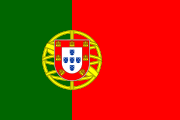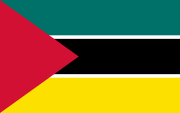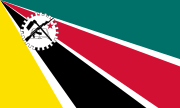Flag of Mozambique
 | |
| Use | National flag and ensign |
|---|---|
| Proportion | 2:3 |
| Adopted | 1 May 1983 |
| Design | A horizontal tricolour of green, black, and gold with white fimbriations and a red isosceles triangle at the hoist. The triangle is charged with a five-pointed gold star which has above it a bayonet-equipped firearm crossed by a hoe, superimposed on an open book. |
| Designed by | FRELIMO |
The national flag of Mozambique is a horizontal tricolour of green, black, and golden-yellow with white fimbriations and a red isosceles triangle at the hoist. The triangle is charged with a five-pointed gold star in its center, above which there is a bayonet-equipped firearm crossed by a hoe, superimposed on an open book. The colours and symbols of the flag represent different aspects of the Mozambican people and their war of independence.
The current design, adopted on 1 May 1983, is defined in the Constitution of Mozambique, and regulations regarding the flag's use are outlined in decree no. 47/2006, titled State Protocol Standards. The design is based on the first flag of FRELIMO (Mozambique Liberation Front), which has governed the country since its independence from Portugal on 25 June 1975. Since the democratisation of Mozambique in 1990, there have been calls to change the flag, particularly to remove the firearm.
Design
[edit]The design of the flag is described in Title XVI, Article 297 of the Constitution of Mozambique, 2004 (2007 revision):
From top to bottom, there shall be green, black, and gold horizontal stripes, separated by strips of white. On the left side, there shall be a red triangle, in the center of which there shall be a star. Above this there shall be a crossed hoe and gun, superimposed on a book.[1]
While the constitution does not specify the number of points the star on the flag should have, it is universally depicted with five points, as seen, for example, on the official website of the Mozambican government.[2] Similarly, the particular gun used in the design is not mentioned in the constitution, but it is generally understood to be an AK-47 with a bayonet attached.[3][4][5] It is the only national flag that features a modern firearm.[6]
Colours
[edit]The flag's colours are constitutionally defined, but their specific shades are not.[1] The London Organising Committee of the Olympic and Paralympic Games used the following Pantone colour codes in 2012: green, PMS 355; yellow, PMS 109; and red, PMS 185.[7] However, these shades differ from those used on the flag displayed on the Mozambican government's official website, which are green, PMS 328; yellow, PMS 102; and red, PMS 186.[8]
Symbolism
[edit]The Mozambican constitution explains the significance of the flag's colours and symbols. Red represents anti-colonial resistance and national defence, green represents the country's soil; golden-yellow represents the country's subsoil, black represents the African continent, and white represents peace and "the justice of the struggle of the Mozambican people". The star represents "the spirit of international solidarity of the Mozambican people", while the book, hoe, and gun symbolise education, production, and defence, respectively.[1]
The US Central Intelligence Agency's World Factbook gives a slightly different explanation of the flag's symbolism. It states that yellow represents Mozambique's minerals, the star represents Marxism and proletarian internationalism, the gun represents vigilance in addition to defence, the hoe represents agriculture, and the open book stresses the importance of education.[9]
Protocol
[edit]
The government of Mozambique outlined regulations regarding the use of the national flag in decree no. 47/2006, titled State Protocol Standards.[10] Articles 49 and 50 of the law specify who may fly the flag and where it should be hoisted.[10] The flag may be flown on public or private properties, and at events such as graduation ceremonies and parades.[11] The flag should be flown at several locations, particularly state institutions, including government offices, barracks, airports, schools, and hospitals.[a][11] The following individuals are entitled to display the flag on their vehicles: the president of the country, the prime minister, the president of the Assembly of the Republic, the president of the supreme court, the president of the administrative court, the president of the constitutional council, provincial governors, and heads of diplomatic missions.[12]
Despite the law, many state institutions and official residences hoist substandard flags or no flag at all due to financial and logistical challenges. For example, a 2023 report by the Mozambican newspaper O País ("The Country") found that most of these buildings in the western city of Tete did not fly the national flag. Those that did flew flags "in poor condition and with altered colors", including a flag at Francisco Manyanga Secondary School that was "completely torn".[13]
Historical flags
[edit]During the Portuguese colonial period, Mozambique flew the Portuguese flag.[14] The Mozambican War of Independence between Portugal and FRELIMO (Mozambique Liberation Front) ended in September 1974 with the signing of the Lusaka Accord and the formation of a transitional government.[15] During Mozambique's transition to independence, the flag of Portugal flew alongside the then flag of FRELIMO, which was similar to the country's current flag but without any charges on the triangle.[16][17] American vexillologist Whitney Smith suggests that the design may have been inspired by the flag of Tanganyika, where FRELIMO had been operating in exile.[16] British vexillologist William Crampton meanwhile claims that the flag of South Africa's African National Congress was the source of FRELIMO's inspiration.[18]
The People's Republic of Mozambique proclaimed its independence on 25 June 1975, and a new national flag was hoisted in place of the Portuguese and FRELIMO flags.[16][19] The new flag's design and significance were defined in Title IV, Article 68 of the Constitution of the People's Republic of Mozambique (in effect from 1975 to 1990).[20][21] The flag consisted of four diagonal stripes emanating from the upper hoist, separated by white fimbriations. The stripes were, from top to bottom, green, red, black, and yellow. Near the upper hoist was a white cogwheel, charged with a red star and an AK-47 crossed by a hoe, superimposed on an open book.[20] The colours and symbols of the People's Republic flag retained by the current flag share the same meaning. The other symbols were given the following significance by the Mozambican government: the cogwheel represents the working class and industrial production, while the red star represents proletarian internationalism.[20] The flag was changed in April 1983 to an alteration of the FRELIMO flag; the previous flag's charge was placed on top of a large yellow star inside the red triangle. The cogwheel was removed shortly thereafter on 1 May 1983, leading to the flag's present design.[17]
-
Flag of Portugal
(30 June 1911 – present) -
 First flag of FRELIMO
First flag of FRELIMO
Proposals to change the flag
[edit]The drafting of a new Mozambican Constitution in 1990 started discussions on changing the country's national symbols, including the national flag.[22] Critics argued that, because the national flag resembled the flag of FRELIMO, it was antithetical to calls for national unity.[23] Jorge Rebelo, a member of FRELIMO's political bureau, acknowledged the debates surrounding the flag but stated that it would remain unchanged.[22] Since then, the primary criticism has been directed at the inclusion of the AK-47 on the flag, which some Mozambicans view as an allusion to violence.[23]
In 2005, the Mozambican government held a competition to design a new national flag and emblem, as part of a peace agreement between FRELIMO and RENAMO (Mozambican National Resistance).[24] RENAMO had fought FRELIMO in a civil war that lasted sixteen years, before it became Mozambique's main opposition party.[25] RENAMO called for the removal of the AK-47 and star from the flag.[24] José Gabriel Manteigas, a RENAMO member of parliament, gave the following critique:
As a peaceful country, you can't have a flag with a gun on it. For children growing up now in peace, they see a flag with a gun on it, and it doesn't make sense. As for the star, anyone who has seen the Soviet flag knows that a star is the mark of communism. It is true that the Mozambique flag's yellow star seems borrowed from an earlier FRELIMO flag with a crossed hammer and hoe under a yellow star, a blood relative of the old Soviet hammer and sickle.[24]
Then Mozambican president Joaquim Chissano, previously the leader of FRELIMO, responded to Manteigas's criticisms by saying: "If Mozambique's single star were to symbolise communism, the Stars and Stripes would place the United States among the world's most leftist nations."[24] In further defence of the flag, FRELIMO supporters argued that the AK-47 is a symbol of the Mozambican people's determination to protect their country, and the star is a symbol of African solidarity.[24]
A total of 169 entries were received during the 2005 competition, all of which were reviewed by a panel of five judges.[24] The proposals were ultimately rejected by the Assembly of the Republic, which voted 155 to 79 against changing the flag. All the votes against were from FRELIMO, and all the votes for were from RENAMO.[26]
Notes
[edit]- ^ The full list of locations is:
- Presidency of the Republic
- Red Point Palace (Palácio da Ponta Vermelha)
- Assembly of the Republic
- Residence of the President of the Assembly of the Republic
- Prime Minister's office and official residence
- Courts and Constitutional Council
- Ministries
- Provincial Governors' offices and their respective residences
- Diplomatic and consular missions of the Republic of Mozambique abroad and residences of their respective heads of mission
- Barracks
- Police command of the Republic of Mozambique and police posts
- Municipal councils
- District directorates and services
- District headquarters and administrative posts
- Delegations and sub-delegations
- Community leaders' residences
- Public and private schools
- Public and private hospitals
- Airplanes
- Helicopters
- Balloons
- Ships
- Ports, airports and all border crossings
- Headquarters of political parties and social organisations
- Other public establishments
References
[edit]Citations
[edit]- ^ a b c Constitution of the Republic of Mozambique 2007, p. 97, Title XVI, Article 297.
- ^ Government of Mozambique 2015.
- ^ Encyclopædia Britannica 2024: "The symbolic value of the AK-47 to such movements is demonstrated by its presence on the coats of arms of numerous countries as well as on the flag of Mozambique."
- ^ Chivers 2011, p. 15: "An AK-47 with bayonet attached appears on the flag of Mozambique ..."
- ^ Wheeler 1990, p. 161: "Samora Machel, who declared the country's name as the People's Republic of Mozambique and placed a depiction of a Soviet AK47 Kalashnikov on the national flag."
- ^ Marshall 2017, p. 73: "The single most interesting thing about it is the AK-47 assault rifle with a fixed bayonet on its left-hand side. This is the only national flag in the world with a modern weapon symbolised on it."
- ^ LOCOG 2012, p. 74.
- ^ Colours taken from SchemeColor.com, which displays the same flag as the Mozambican government's official website (Government of Mozambique 2015).
- ^ Central Intelligence Agency 2024.
- ^ a b Organización Internacional de Protocolo 2024.
- ^ a b Government of Mozambique 2006, Decree no. 47/2006, Article 49.
- ^ Government of Mozambique 2006, Decree no. 47/2006, Article 50.
- ^ O País 2023.
- ^ Mohr 1975.
- ^ Munslow 1988, p. 25.
- ^ a b c Smith 2001.
- ^ a b Flag Research Center 1983, p. 242.
- ^ Crampton 1990, p. 40.
- ^ Zeman 2024, p. 248.
- ^ a b c Constitution of the People's Republic of Mozambique 1975, Title IV, Article 68.
- ^ Hall & Young 1991, p. 102.
- ^ a b Seleti 1997, p. 57.
- ^ a b Marshall 2017, p. 73.
- ^ a b c d e f Wines 2005.
- ^ Morier-Genoud, Cahen & do Rosário 2018, p. 1.
- ^ Reuters 2005.
Sources
[edit]- "A Bandeira Nacional" [The National Flag] (in Portuguese). Maputo: Government of the Republic of Mozambique. 22 June 2015. Archived from the original on 13 August 2015.
- "AK-47". Encyclopædia Britannica. Encyclopædia Britannica, Inc. 18 July 2024.
- "Are you passionate about your flag?". BBC News. 23 December 2005. Archived from the original on 24 December 2005.
- "Boletim da República, 26 de Dezembro de 2006" [Bulletin of the Republic, 26 December 2006] (PDF) (in Portuguese). Maputo: Government of the Republic of Mozambique. 26 December 2006.
- Chivers, C. J. (6 September 2011). The Gun. Simon and Schuster. ISBN 978-0-7432-7173-8.
- "Constituição da República Popular de Moçambique" [Constitution of the People's Republic of Mozambique] (PDF) (in Portuguese). Maputo: Government of the People's Republic of Mozambique. 20 June 1975. Archived from the original (PDF) on 3 June 2019.
- "Constitution of the Republic of Mozambique" (PDF). Translated by MOZLEGAL. Maputo: Government of the Republic of Mozambique. 2007.
- Crampton, William G. (1990). The World's Flags. BDD Promotional Book Company, Incorporated. ISBN 978-0-7924-5073-3. Retrieved 15 October 2024.
- Flags and Anthems Manual: London 2012 (PDF). London, United Kingdom: London Organising Committee of the Olympic and Paralympic Games. 2012. Archived from the original (PDF) on 2015-01-04. Retrieved 24 August 2024.
- Hall, M.; Young, T. (1991). "Recent Constitutional Developments in Mozambique". Journal of African Law. 35 (1/2): 102–115. doi:10.1017/S002185530000838X. ISSN 0021-8553. JSTOR 745496. Retrieved 23 December 2024.
- "Instituições do Estado funcionam sem bandeira hasteada em Tete" [State institutions operate without the flag flying in Tete]. O País (in European Portuguese). 27 July 2023. Retrieved 18 October 2024.
- Marshall, Tim (4 July 2017). A Flag Worth Dying For: The Power and Politics of National Symbols. Simon and Schuster. ISBN 978-1-5011-6835-2.
- Mohr, Charles (25 June 1975). "Mozambique Independent Of Lisbon After 470 Years". The New York Times.
- Morier-Genoud, Eric; Cahen, Michel; do Rosário, Domingos Manuel (2018). The War Within: New Perspectives on the Civil War in Mozambique, 1976–1992 (NED – New ed.). Boydell & Brewer. ISBN 978-1-84701-180-0. JSTOR 10.7722/j.ctt2111dhd.
- "Mozambique". The World Factbook. Central Intelligence Agency. 30 July 2024.
- "Mozambique". Organización Internacional de Protocolo (in Spanish). 2 May 2024. Retrieved 15 October 2024.
- "Mozambique Flag Colors". SchemeColor.com. Retrieved 23 December 2024.
- "Mozambique: Parliament Keeps Gun In National Flag". The New York Times. Reuters. 20 December 2005.
- Munslow, Barry (1988). "Mozambique and the Death of Machel". Third World Quarterly. 10 (1): 23–36. doi:10.1080/01436598808420041. ISSN 0143-6597. JSTOR 3992800.
- Seleti, Yonah (January 1997). "The transition to democracy and the production of a new national identity in Mozambique". Critical Arts. 11 (1–2): 46–62. doi:10.1080/02560049785310061. ISSN 0256-0046.
- Smith, Whitney (16 February 2001). "Flag of Mozambique". Encyclopædia Britannica. Encyclopædia Britannica, Inc.
- The Flag Bulletin. Vol. 22. Flag Research Center. 1983.
- Wheeler, Jack (1990). "Mozambique". In Radu, Michael (ed.). The New Insurgencies: Anti-Communist Guerrillas in the Third World (1st ed.). Transaction Publishers. ISBN 978-1-4128-3800-9.
- Wines, Michael (7 October 2005). "Symbols Are Important. So What Does a Gun Symbolize?". The New York Times. Archived from the original on 29 May 2015.
- Zeman, Andreas (9 May 2024). "Flag Independence without Flags? Mozambican Decolonization on the Periphery of the New Nation". e-Journal of Portuguese History. 21 (2): 246–267. doi:10.1163/16456432-20040005.
External links
[edit] Media related to National flag of Mozambique at Wikimedia Commons
Media related to National flag of Mozambique at Wikimedia Commons- Mozambique at Flags of the World




